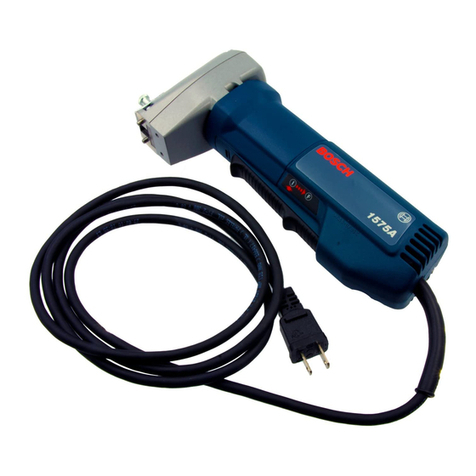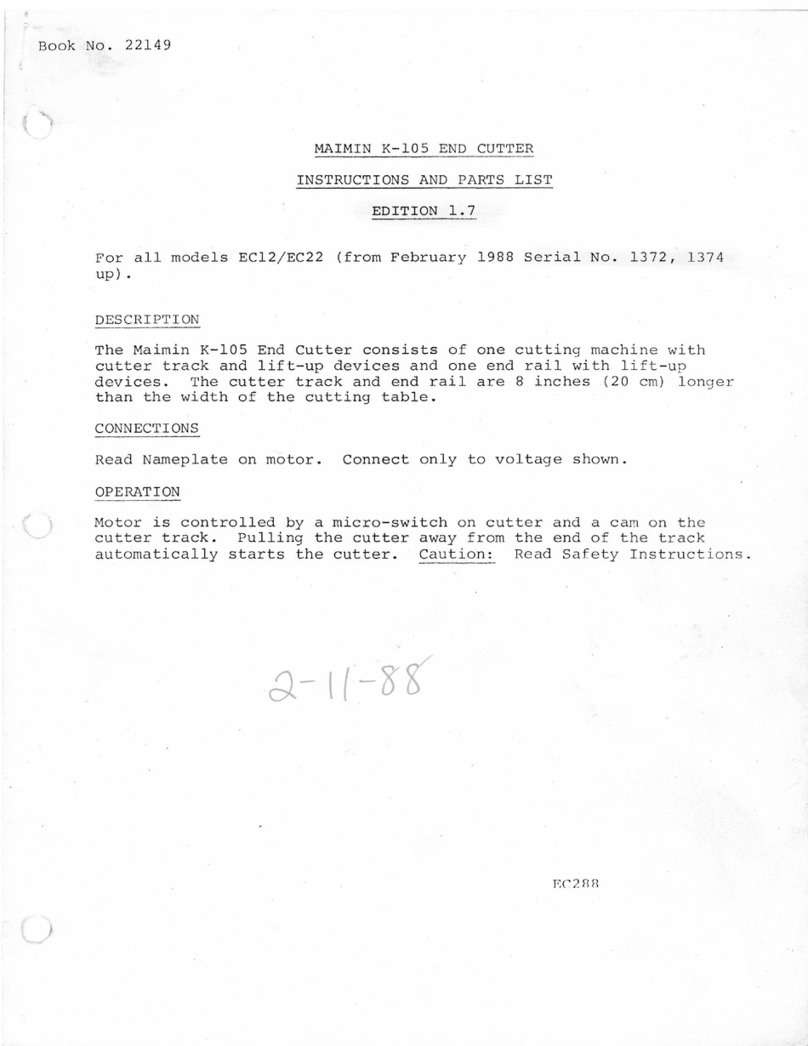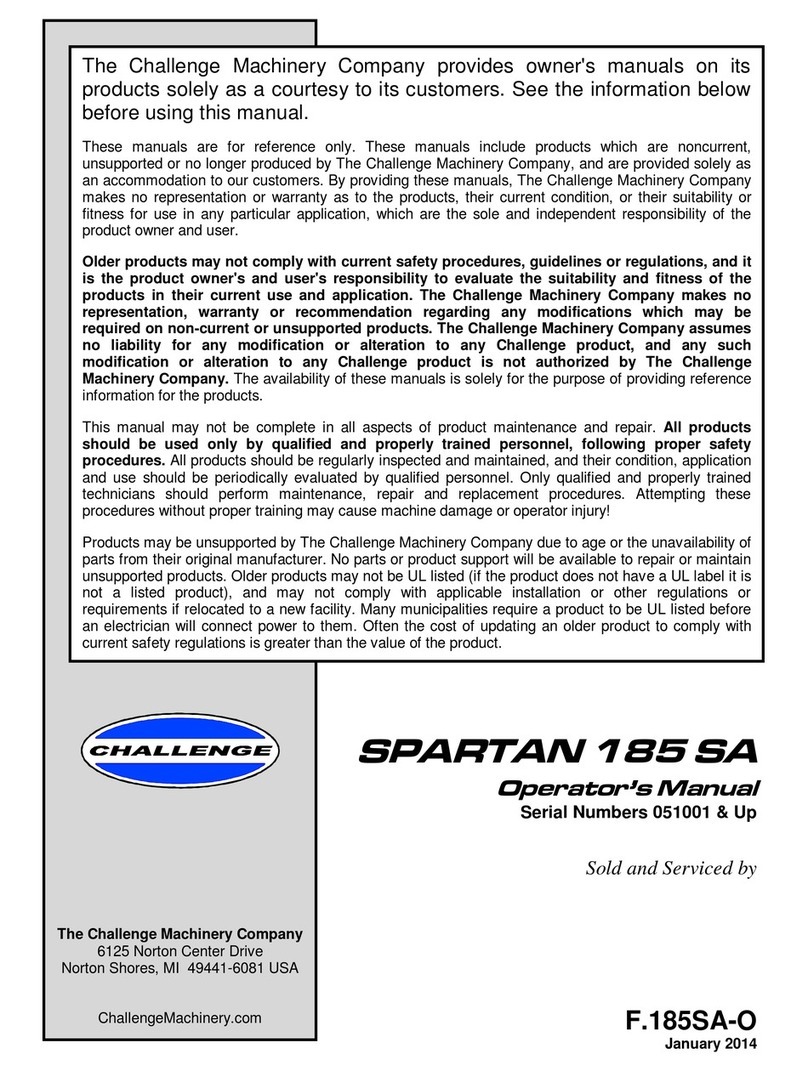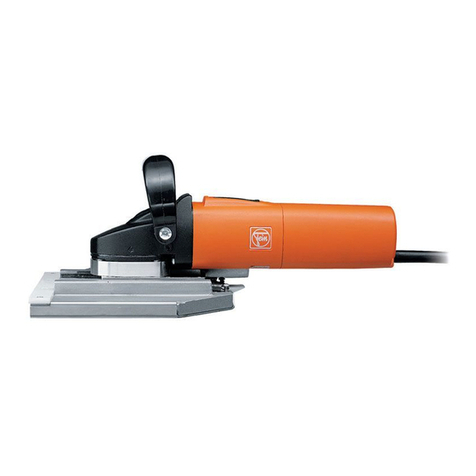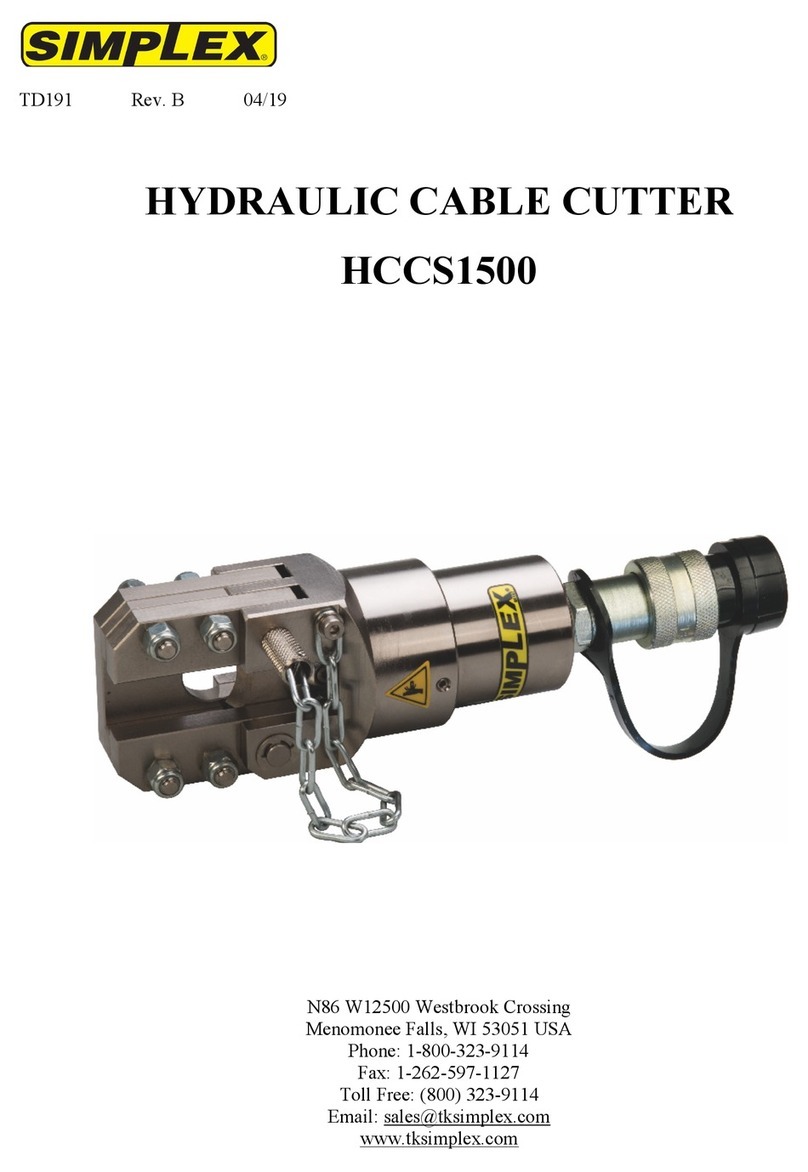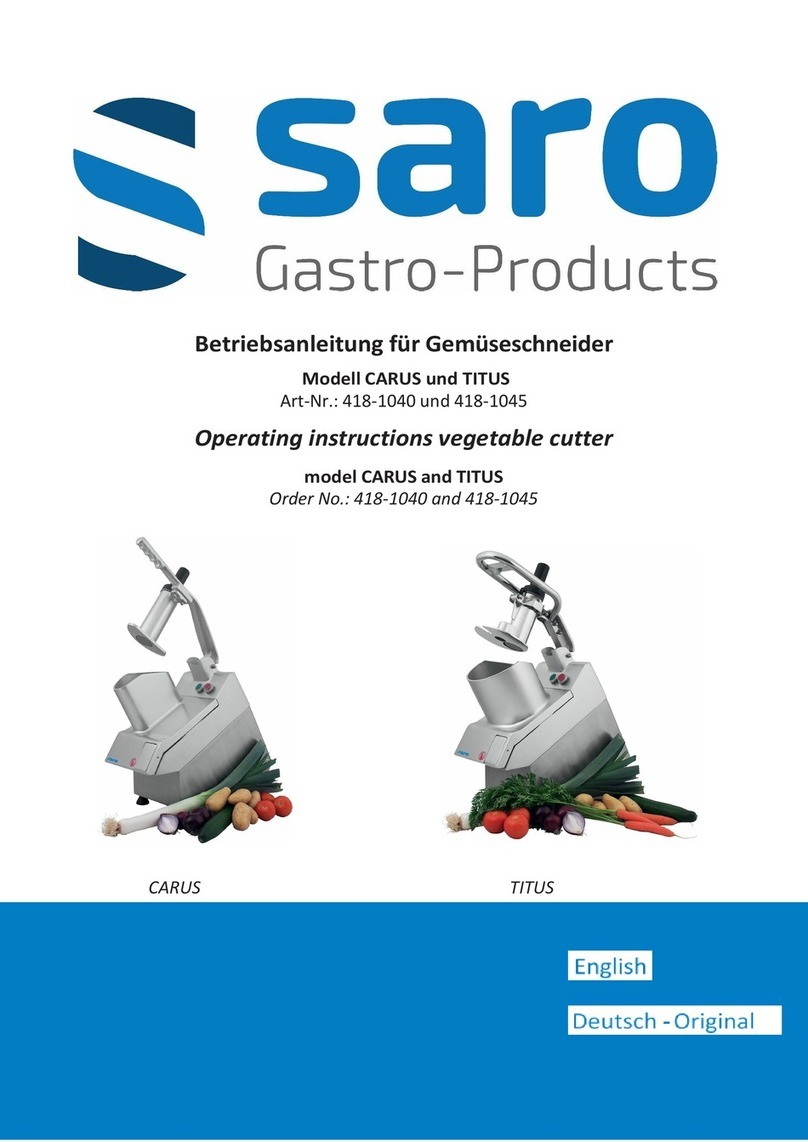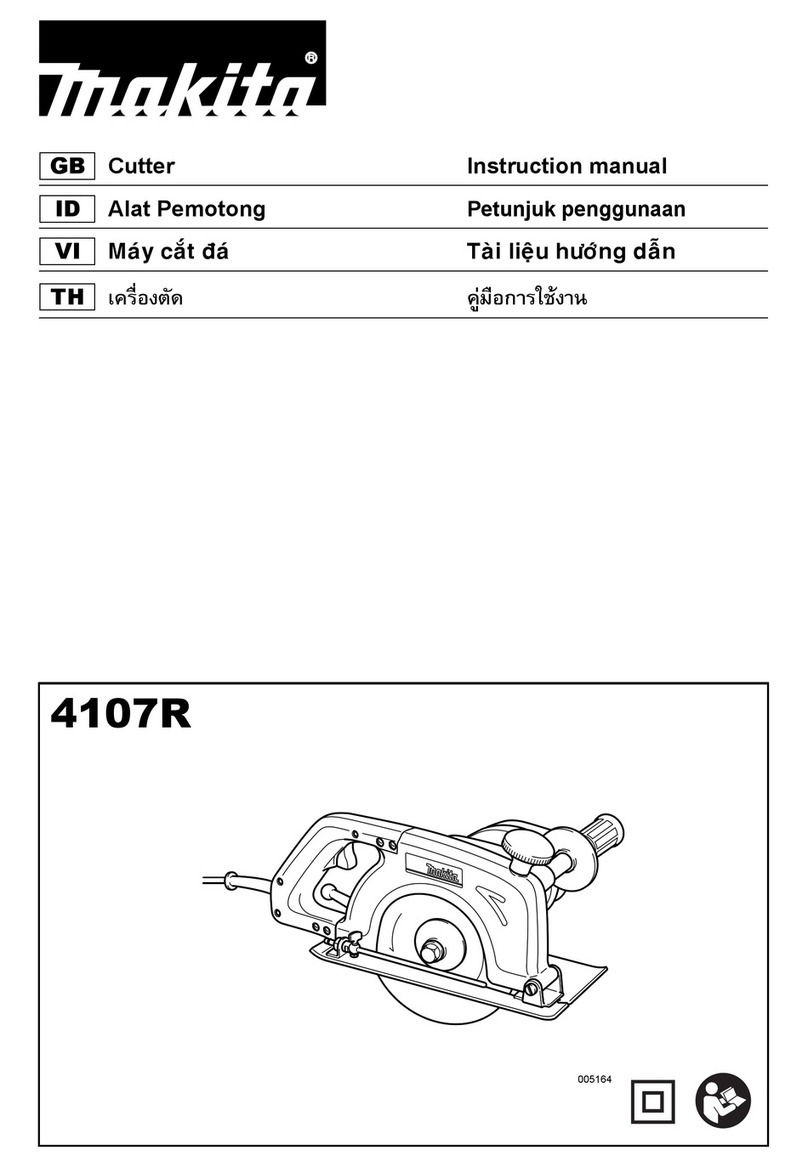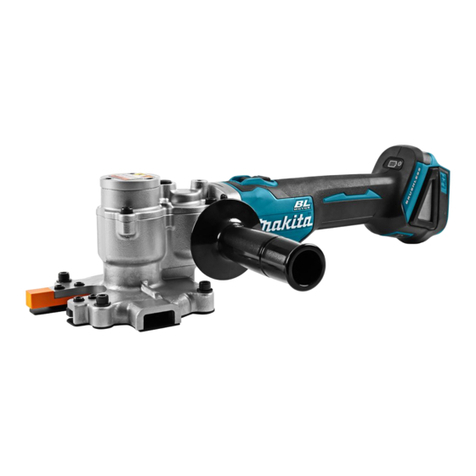PRO BAUTEAM Easycutter Series User manual

1
de Bedienungsanleitung Easycutter
en Operating manual: Easycutter
fr Mode d’emploi Easycutter
it Istruzioni per l’uso Easycutter

2
DE Easycutter
EN Easycutter
FR Easycutter
IT Easycutter

3
B + D
B
M6
1x
C
D6
1x
A
M6 x 20
4x
A
DE SCHNEIDEDRAHT
EN CUTTING WIRES
FR FILS DE COUPE
IT FILI DI TAGLIO

4
SICHERHEITSHINWEISE
Lesen Sie alle Sicherheitshinweise und Anweisungen. Versäumnisse können elektrischen Schlag, Brand, Explo-
sion oder Verletzungen verursachen. Bewahren Sie alle Sicherheitshinweise und Anweisungen für die Zukunft
auf. Die in den Sicherheitshinweisen verwendete Begriff „Elektrowerkzeug“ beziehen sich auf den Hartschaum-
schneider. Der Begriff: „Einsatzwerkzeug“ bezieht sich auf das Zubehör, z.B. auf die Schneidedrähte, Klingen, etc.
ARBEITSPLATZSICHERHEIT
BRANDSCHUTZ UND GESUNDHEIT: BESONDERE SICHERHEITSHINWEISE IM UMGANG MIT HARTSCHÄUMEN
AUS EXPANDIERTEM POLYSTYROL (EPS, STYRODUR©, STYROPOR®), POLYSTYROL-EXTRUDERSCHAUM-
STOFF (XPS) ODER ÄHNLICHEM IM BEZUG AUF EXPLOSIONSGEFAHR UND GEFÄHRLICHE DÄMPFE.
1. Beachten Sie, dass Aufbewahrung, Handhabung und Anbringen von Hartschäumen
besonderen Sicherheitsbestimmungen unterliegt. Lesen und befolgen Sie alle Sicherheits-
hinweise und Anweisungen des Hartschaumherstellers.
2. Beachten Sie, dass während der Verarbeitung von Hartschäumen, besonders beim
Schneiden mit erhitzten Drähten oder Klingen, entzündlichen oder gesundheitsbedenk-
lichen oder gesundheitsschädlichen Dämpfe wie z.B. Pentan, Styrol etc. entweichen
können. Lesen Sie dazu die Hinweise des Herstellers, beachten Sie die MAK-Werte und
befolgen Sie diesbezüglichen Anweisungen des Herstellers. Desweiteren sorgen Sie vor
jeder Inbetriebnahme und Reinigung für einen sicheren Arbeitsbereich, indem Sie fol-
gende Hinweise befolgen:
2.1 Keine Materialien mit einer Erweichungstemperatur von unter 100 °C (212 °F) verwenden.
2.2 Keine Materialien mit einer Zündtemperatur unter 300 °C (572 °F) verwenden.
2.3 Keine selbstentzündliche und keine leichtent ammbare Materialien nach der Norm
EN 13501-1 / DIN 4102-1 verwenden.
2.4 Keine Materialien verwenden, die explosionsgefährlich oder brandfördernd sein
können.
2.5 Das gesamte Arbeitsumfeld muss frei von jeglichen Zündquellen sein, wie z.B. an-
dere eingeschaltete elektromotorbetriebene Elektrowerkzeuge (Funkenbildung), offenes
Feuer, angezündete Zigaretten oder Ähnliches.
2.6 Halten Sie Ihr Arbeitsumfeld sauber, staubfrei, gut beleuchtet, um Brand- und Explo-
sionsgefahr sowie Gesundheitsschädigungen durch Dämpfe zu vermeiden.
Inbetriebnahme bei geschlossenen Türen und Fenstern ist nicht gestattet. Halten Sie
Ihren Arbeitsumfeld gut belüftet, um das Einsammeln von entzündlichen und/oder ge-
sundheitsgefährdenden Dämpfen zu vermeiden.
Berücksichtigen Sie, dass die entzündlichen Dämpfe in der Regel schwerer sind als Luft
und sich in Bodennähe stauen können. Sorgen Sie daher für die ausreichende Absau-
gung der entstehenden Dämpfe sowie für gute Raumbelüftung auch im Bodenbereich.
Berücksichtigen Sie, dass die Lichtbogenbildung nicht ausgeschlossen werden kann.
2.7 Während eines Schneidvorgangs können sich am Elektrowerkzeug elektrostatische
Au adungen bilden, die zu einer Funke- oder Flammenbildung führen können.
Sie dürfen das Elektrowerkzeug nicht verwenden, wenn der Arbeitsbereich durch brenn-
bare Gase, Stäube oder Flüssigkeiten explosionsgefährdet ist oder wenn der Arbeitsbe-
reich unter Explosionsschutz-Verordnung gestellt wurde.
ELEKTRISCHE SICHERHEIT
3. Überprüfen Sie das Netzkabel vor jeder Inbetriebnahme auf Beschädigungen. Gehen Sie
DEUTSCH

5
mit dem Netzkabel sorgfältig um: Vermeiden Sie ein enges Aufrollen/Verbiegen des Ka-
bels, ziehen Sie Netzkabel immer am Stecker aus der Steckdose, halten Sie das Kabel fern
von Hitze, Öl, und scharfkantigen Ecken, lagern Sie das Kabel nicht als Kabelsalat.
4. Stellen Sie sicher, dass Sie den Anschlussstecker an ein ordnungsgemäß geerdetes
Stromnetz mit Schutzleiter anschließen. Der Anschlussstecker muss in die Steckdose
passen. Beachten Sie die Netzspannung! Die Spannung der Stromquelle muss mit den
Angaben auf dem Typenschild des Ladegerätes übereinstimmen.
5. Es wird ein Leitungsschutzschalter C16 A oder stärker empfohlen.
6. Wenn Sie mit dem Gerät im Freien arbeiten müssen, verwenden Sie nur Verlängerungs-
kabel, die auch für den Außenbereich zugelassen sind.
Schützen Sie sich vor Stromschlägen!
7. Während das Gerät am Stromnetz angeschlossen ist, verhindern Sie den Körperkontakt
zu geerdeten Oberächen, z.B. Rohren, Heizkörpern, Kühlschränke etc..
8. Beim Arbeiten halten Sie das Gerät an den isolierten Griffächen.
9. Das Gerät darf während der Vorbereitung der Inbetriebnahme, der Wartung
und Reinigung nicht ans Stromnetz angeschlossen sein.
10. Bei Nässe dürfen weder Personen im Arbeitsbereich noch das Gerät mit dem ausgetre-
tenem Wasser in Kontakt kommen. Sorgen Sie dafür, dass kein Regen oder Nässe in das
Elektrowerkzeug eindringt. Nassbetrieb ist strikt verboten.
11. Das Gerät ist ohne Personenschutzschalter. Bearbeiten Sie deshalb keine angefeuchteten
Materialien, feuchte Flächen, arbeiten Sie nicht in einer feuchten Umgebung.
12. Gleichzeitiger Betrieb von mehreren Elektrowerkzeugen führt zu Überlastungen und kann
ggf. einen Brand, Kurzschluss und irreparablen Geräteschaden auslösen.
13. Reinigen Sie regelmäßig die Geräteoberäche sowie die Lüftungsschlitze des Elektro-
werkzeugs. Beachten Sie, dass das Motorgebläse Staub in das Gehäuse zieht. Eine starke
Ansammlung von leitfähigem Staub (zum Beispiel Metallstaub, feuchtem Staub) kann unter
Umständen einen elektrischen Schlag verursachen.
SICHERHEIT VON PERSONEN
14. Sobald das Gerät an Stromnetz angeschlossen ist, berühren Sie nie mit Körperteilen
das Einsatzwerkzeug, Klinge oder den Schneidedraht. Während der Verwendung des
Elektrowerkzeuges greifen Sie nie unter die Hartschaumplatte bzw. halten Sie nie die
Hartschaumplatte in der Hand oder über das Bein fest. Andersfalls riskieren Sie starke
Verletzungen. Beachten Sie, dass die Handschuhe oder Kleidung keinen sicheren Schutz
vor Verletzungen oder Verbrennungen durch erhitztes Einsatzwerkzeug bieten. Beachten
Sie nach dem Trennen des Elektrowerkzeuges vom Stromnetz die Abkühlzeit der Einsatz-
werkzeuge.
15. Vermeiden Sie ungewolltes Anschalten.
Bevor Sie das Gerät an Stromversorgung anschließen, stellen Sie sicher, dass der
Schalter auf AUS steht und das Einsatzwerkzeug still steht und abgekühlt ist.
Das Gerät muss ausgeschaltet werden und das Einsatzwerkzeug abgekühlt, bevor Sie
das Gerät ablegen oder das Werkstück wechseln.
Vor jedem Wechsel der Einsatzwerkzeuge, Wartung- und Reinigung muss der Netz-
stecker gezogen werden. Beachten Sie, dass das Einsatzwerkzeug nicht gleich mit dem
Ausschalten des Gerätes kalt wird. Warten Sie, bis das Einsatzwerkzeug zum Stillstand
gekommen ist und abgekühlt hat.
16. Das Einsatzwerkzeug muss komplett montiert und verriegelt werden, bevor das Gerät
eingeschaltet wird. Verwenden Sie ausschließlich die Originaleinsatzwerkzeuge.

6
17. Sichern Sie die Hartschaumplatte gegen das Verrutschen, um nicht versehentlich mit
dem erhitzten Einsatzwerkzeug in Berührung zu kommen.
18. Entfernen Sie Einstellwerkzeuge (z.B. Schraubenschlüssel) und halten Sie den Arbeits-
bereich sauber, bevor Sie das Gerät einschalten.
19. Beim Schneiden von Hartschäumen können Dämpfe entstehen, die zur Haut-, Au-
gen- und/oder zur Atemwegeirritationen führen können. Tragen Sie daher entsprechende
Schutzkleidung, Handschuhe, Schutzbrille und eine Mund-Nase-Filtermaske.
20. Gehen Sie vorsichtig mit beweglichen Teilen des Gerätes um. Binden Sie Ihr Haar zu-
sammen, tragen Sie keinen Schmuck oder weite Kleidung. Andernfalls können sich diese
in bewegenden Geräten oder Einsatzwerkzeugen verfangen.
21. Während der Arbeit achten Sie auf einen ausbalancierten festen Stand und Griff. Arbei-
ten Sie nicht auf einer Leiter.
22. Achten Sie auf jegliche Anzeichen von Ermüdung Ihres Körpers und brechen Sie die
Arbeit bei Ermüdungserscheinung ab.
23. Sollten Sie unter Schlafentzug leiden oder unter dem Einuss von Alkohol, Rauschmitteln
oder Medikamenten stehen, dürfen Sie das Elektrowerkzeug nicht verwenden.
24. Lassen Sie erwachsene Personen das Gerät nicht benutzen, die diese Anweisungen
nicht gelesen haben oder nicht befolgen können.
25. Kinder und Jugendliche dürfen das Gerät und Einsatzwerkzeuge nicht benutzen. Unter-
weisen Sie die Kinder, dass Sie mit den oben genannten Gegenständen nicht spielen dürfen.
Bewahren Sie diese Gegenstände außerhalb der Reichweite von Kindern auf.
VERWENDUNG DES ELEKTROWERKZEUGES UND DER EINSATZWERKZEUGE
26. Überlasten Sie das Gerät nicht und verwenden Sie das Gerät und seine Einsatzwerk-
zeuge entsprechend diesen Anweisungen und des bestimmungsgemäßen Gebrauchs.
Andernfalls bestehen Risiken für Gesundheit und Leben.
27. Vor jeder Benutzung des Gerätes müssen Sie alle Schutzvorrichtungen, Kabelverbin-
dungen, Zubehörteile und Einsatzwerkzeuge gründlich auf Beschädigungen überprüfen,
um sicherzustellen, dass das Gerät und seine Einsatzwerkzeuge ordnungsgemäß und
mit allen Funktionen arbeiten. Führen Sie folgende Schritte durch:
27.1 Bei Elektrowerkzeugen mit Klingen und Aufsätzen: Ziehen Sie lockeren Schrauben
an. Bei Elektrowerkzeugen mit Draht: Überprüfen Sie die Federn und Spannung des
Schneidedrahtes. Beachten Sie, dass insbesondere der Draht unter Spannung eingesetzt
wird. Ein verschlissener Draht kann schlagartig zerspringen und ernsthafte Verletzungen
verursachen. Tragen Sie daher immer eine Schutzbrille!
27.2 Überprüfen Sie das Gerät vor jedem Gebrauch auf Beschädigungen, Risse, Verformun-
gen oder auffällige Verschleißspuren. Wenn vorhanden, verwenden Sie das Gerät nicht.
27.3 Überprüfen Sie die Ausrichtung und Verbindungen der Einsatzwerkzeuge und aller
beweglichen Teilen sowie die des Kabels auf Brüche, stärkere Verschleißspuren, sonstige
Beeinträchtigungen und jegliche anderen Umstände, die den Betrieb beeinussen kön-
nen. Wenn vorhanden, verwenden Sie das Gerät und/oder die Einsatzwerkzeuge nicht.
27.4 Verschlissene Schutzvorrichtungen oder andere defekte Teile müssen durch eine au-
torisierte Werkstatt fachgerecht repariert oder ersetzt werden. Beschädigte oder verschlis-
sene Einsatzwerkzeuge dürfen nicht repariert werden, sondern müssen ersetzt werden.
27.5 Wenn Sie das Einsatzwerkzeug überprüft und eingesetzt haben, führen Sie Test-
schritte wie in dem Abschnitt „Inbetriebnahme“ beschrieben durch, um die eventuell

7
unentdeckten Beschädigungen an den Einsatzwerkzeugen im Testlauf zu identizieren.
Andere Personen während des Tests fernhalten.
28. Einsatzwerkzeuge müssen genau in die Werkzeugaufnahme passen und dürfen nur
für die empfohlenen Einsatzmöglichkeiten verwendet werden. Verwenden Sie kein Ein-
satzwerkzeug, das vom Hersteller nicht speziell für dieses Elektrowerkzeug vorgesehen
wurde. Im Fall, wenn ein Einsatzwerkzeug aus nicht autorisierter Herstellung an dem
Elektrowerkzeug befestigt wird, ist eine Garantie für sichere Verwendung ausgeschlos-
sen. Die Verwendung von Zwischenlagen, Reduzierbuchsen oder Adapter ist untersagt.
29. Verbrennungsgefahr: Halten Sie nie die Hand vor dem erhitzten Einsatzwerkzeug.
Berühren Sie nie mit Körperteilen das erhitzte Einsatzwerkzeug. Während der Verwendung
des Elektrowerkzeuges greifen Sie nie unter die Hartschaumplatte bzw. halten Sie nie die
Hartschaumplatte in der Hand oder über das Bein fest. Andersfalls riskieren Sie starke Ver-
brennungen durch das versehentliche Berühren des erhitzten Einsatzwerkzeuges. Beach-
ten Sie, dass die Handschuhe oder Kleidung keinen sicheren Schutz vor Verletzungen oder
Verbrennungen durch stark erhitztes Einsatzwerkzeug bieten. Nach dem Ausschalten be-
achten Sie die Abkühlzeit des Einsatzwerkzeuges, bevor Sie das Elektrowerkzeug ablegen.
30. Gesundheitsgefährdende Werkstücke wie z.B. Asbest dürfen nicht verarbeitet werden.
SERVICE
40. Das Gerät darf ausschließlich von qualiziertem Fachpersonal und mit Original-
Ersatzteilen repariert werden. Einsatzwerkzeuge dürfen nicht repariert werden, sondern
müssen ersetzt werden.
Technische Daten Easycutter I Easycutter II
Schnittlänge 1.070 mm 1.350 mm
Schnitttiefe 320 mm 320 mm
Gewicht 10 kg 10 kg
Trafo mit
Thermosicherung
40 V / 160 Watt / 230V – 50/60Hz /
IP 54
40 V / 200 Watt / 230V – 50/60Hz /
IP 68
BESTIMMUNGSGEMÄSSER GEBRAUCH
Das Gerät ist zum Schneiden von Polystyrol-Hartschaumplatten (z.B. Styropor oder Styrodur)
für Gebäudedämmung bestimmt. Die Hartschaumplatten sollen dabei frei von Kleber, Kleber-
rückständen und anderen Verunreinigungen sein.
MONTAGE
Ziehen Sie den Stecker und lesen Sie alle Sicherheitshinweise vor der Montage. Versäumnisse
können elektrischen Schlag, Geräteschaden oder sehr schwere Verletzungen verursachen.
Die folgende Aufbauanleitung beschreibt alle Modelle und Sonderausstattungen
des Easycutters. Bitte beachten Sie, dass Ihr Gerät nicht mit allen beschriebenen
Bauteilen/Zubehör ausgestattet sein könnte. Genauen Lieferumfang entnehmen
Sie bitte Ihrer Bestellbestätigung.
Aufbauanleitung: Seiten 2-3
i

8
INBETRIEBNAHME
Lesen Sie alle Sicherheitshinweise und Anweisungen vor der Inbetriebnahme. Versäumnisse können
elektrischen Schlag, Geräteschaden oder sehr schwere Verletzungen verursachen.
Ein- und Ausschalten
1. Trafokabel mit XLR-Stecker (1) in den Bügel einstecken.
2. Den Ein-und-Ausschalter (2) im Bügel drücken.
Der Schneidedraht innerhalb von Millisekunden auf seine Betriebstemperatur.
3. Bügel in Richtung Material schieben - Material wird geschnitten.
4. Achtung: Brandgefahr: Nach jedem erfolgten Schnitt den Ein-und Ausschalter
loslassen, der Schneidedraht kühlt in wenigen Sekunden ab.
DRAHTWECHSEL
Lesen Sie alle Sicherheitshinweise und Anweisungen vor der Wartung oder Drahtwechsel. Versäumnis-
se können elektrischen Schlag, Explosion, Geräteschaden oder sehr schwere Verletzungen verursachen.
1. Drahtreste durch Aushängen an der oberen und unteren Drahtaufnahme entfernen.
2. Der neue Draht wird zuerst auf der einen Seite in die Feder eingehängt und dann unter
Zugspannung auf der gegenüberliegenden Seite eingehängt.
GERADER SCHNITT
Bügel-Winkel links und rechts auf 0 Grad einstellen und gewünschtes Abschnittmaß
auf der Polystyrolplatte anzeichnen.
SCHRÄGSCHNITT
Bügel – Winkel links und rechts auf 0 Grad einstellen und gewünschten Winkel mit
dem Anschlaglineal einstellen.
STUFENSCHNITT
Bügel–Winkel links und rechts auf 0 Grad einstellen und gewünschte Stufe (Höhe und
Länge) auf der Polystyrolplatte anzeichnen. Bügel anheben, um die Hartschaumplatte
unter dem Schneidedraht bis an die angezeichnete Länge durch zuschieben.
GEHRUNGSSCHNITT
Bügel Winkel links und rechts auf das gewünschte Winkelmaß einstellen. Dazu wird
der mit gelieferte Winkelanschlag verwendet.
Bügel anheben, um die Hartschaumplatte unter dem Schneidedraht bis an den Schnit-
tanfang zuschieben.
HOHLKEHLENSCHNITT
Bügel – Winkel links und rechts auf 0 Grad einstellen und gewünschte Hohlkehle auf
der Polystyrolplatte anzeichnen. Bügel anheben, um die Hartschaumplatte unter dem
Schneidedraht bis an die angezeichnete Stelle durchzuschieben.
12
SCHNITTVARIANTEN

9
STÖRUNGSBESEITIGUNG, REINIGUNG, ENTSORGUNG
Ziehen Sie den Stecker bevor Sie das Gerät reinigen, Lesen Sie alle Sicherheitshinweise. Versäum-
nisse können elektrischen Schlag, Geräteschaden oder sehr schwere Verletzungen verursachen.
Störungsbeseitung
Sollte das Gerät – vor allem nach längerer ununterbrochener Nutzung – nicht mehr heiß
werden, dann muss der Trafo kurz abkühlen (dieser ist mit einer thermischen Sicherung
versehen).
Reinigung
Besonders Lüftungsöffnungen und die Werkzeugaufnahme sollen nach jedem Gebrauch
mit einem Tuch und Pinsel gereinigt werden. Kommt Druckluft zum Einsatz, sollen 3 bar
nicht überschritten werden. Kunststoffteile nicht mit Lösungsmitteln abwischen.
Entsorgung
Werfen Sie Elektrowerkzeuge nicht in den Hausmüll! Gemäss Europäischer Richtlinie über
Elektro- und Elektronik-Altgeräte und Umsetzung in nationales Recht müssen verbrauchte
Elektrowerkzeuge getrennt gesammelt und einer umweltgerechten Wiederverwertung
zugeführt werden.
Konformitätserklärung
Hiermit erklären wir, dass folgendes Produkt den Bestimmungen der unten gekennzeich-
neten Richtlinien - einschließlich deren zum Zeitpunkt der Erklärung geltenden Ände-
rungen entspricht. Ein nicht mit uns abgestimmter Umbau oder Änderung der Maschine
seitens unautorisierter Dritter beinhaltet den sofortigen Verlust der Gültigkeit dieser
Erklärung.
Produkt: Polystyrolschneider
Einschlägige EG-Richtlinien
98/37/EG
73/23/EWG
2004/108/EC
2006/95/EC
Angewandte Normen
EN 55014-1 (VDE 875 Teil 14-1): 2003-09; EN 55014-1:2000 + A1:2001 + A2:2002
EN 55014-2 (VDE 875 Teil 14-2): 2002-08; EN 55014-2:1997 + A1:2001
EN 61000-3-2 (VDE 838 Teil 2): 2001-12; EN 61000-3-2:2000
EN 61000-3-3 (VDE 838 Teil 3): 2002-05; EN 61000-3-3:1995 + Cor.:1997 + A1:2001
EN 60335-1 (VDE 07000-1):2007-02; EN 60335-1:2002+A11+A1+A12+Corr.:+A2:2006
EN 60335-2-45 (VDE 0700 Teil 45): 2003-06; EN 60335-2-45:2002
EN 50366 (VDE 0700-366):2006-11; EN 50366:2003+A1:2006
Angewandte harmonisierte Normen
EN ISO 12100-1
EN ISO 12100-2
____________
Andre Rahe
Geschäftsführer Bielefeld, 23.08.2011
Pro Bauteam Vertriebs- & Produktionsgesellschaft mbH
Grafenheider Strasse 103 Telefon: 0 521 - 9774401
33729 Bielefeld/ Deutschland Fax: 0 521 - 9774406

10
SAFETY NOTES
Read all safety information and instructions. Failure to comply with these instructions may result in an electric
shock, fire, explosion or injury. Retain all safety information and instructions for future reference.
The terms “electric power tool” and “equipment” used in the safety information and instructions relate to foam
cutter. The term: “application tool” relates to the accessories.
WORK AREA SAFETY
FIRE PROTECTION AND HEALTH: SPECIAL SAFETY INFORMATION WHEN HANDLING RIGID FOAMS MADE
FROM EXPANDED POLYSTYRENE (EPS, STYRODUR©, STYROPOR®), EXTRUDED POLYSTYRENE FOAM (XPS)
OR SIMILAR MATERIALS, IN RELATION TO THE RISK OF EXPLOSIONS AND HAZARDOUS VAPOURS.
1. Please note that the storage, handling and attachment of rigid foams is subject to spe-
cial safety regulations. Read and observe all safety information and instructions from the
rigid foam manufacturer.
2. Please note that during the processing of rigid foams, and particularly when cutting
with heated wires or blades, ammable, potentially harmful or harmful vapours may es-
cape, such as pentane, styrene, etc. For this, please read the manufacturer‘s information,
observe the MAK values and follow the manufacturer’s instruction which relate to this. In
addition, make sure that the work area is safe before every operation and cleaning proce-
dure by following these instructions:
2.1 Do not use any materials with a softening temperature of less than 100 °C (212 °F).
2.2 Do not use any materials with an ignition temperature of less than 300 °C (572 °F). .
2.3 Do not use any self-igniting or easily ammable materials in accordance with the
standard EN 13501-1 / DIN 4102-1.
2.4 Do not use any materials which may be explosive or oxidising.
2.5 The entire work environment must be free from any sources of ignition such as other
electrically-driven power tools that are switched on (spark formation), open ames, lit
cigarettes or similar.
2.6 Keep your work environment clean, dust-free and well-lit in order to prevent the risk
of re and explosions, as well as damage to health, due to vapours.
Operation is not permitted when doors and windows are closed. Keep your work en-
vironment well-ventilated in order to prevent ammable and/or harmful vapours from
collecting.
Bear in mind that the ammable vapours are generally heavier than air and can accu-
mulate near to the ground. For this reason, make sure that any vapours which arise are
sufciently suctioned away, and also ensure that the oor area of the room is well-venti-
lated.
2.7 Keep your work environment clean, dust-free, well-lit, well-ventilated, and free from
ignition sources (such as electric power tools that are switched-on - due to spark forma-
tion - open ames, lit cigarettes) in order to prevent the risk of re, explosion or dama-
ge to health due to vapours or dust. Working in potentially explosive environments is
prohibited.
ELECTRICAL SAFETY
3. Inspect the power cable for damage before the start of each operation. Handle the po-
wer cable with care: Avoid tightly rolling-up/twisting the cable, always pull the cable from
the socket by holding the plug, keep it away from heat, oil and sharp edges, do not store
the cable in a tangled mess.
ENGLISH

11
4. Make sure that you connect the plug to a properly earthed mains supply with a pro-
tective ground conductor. The connecting plug must t in the socket. Observe the mains
voltage! The voltage of the power source must correspond to the information on the type
label of the charging device.
5. It is recommended to use a C16 A circuit breaker, or one more powerful.
6. If you have to work outdoors with the equipment, only use an extension cord authorised
for use in outdoor areas.
Protect yourself against electric shocks!
7. While the device is connected to the mains supply, prevent it coming into physical con-
tact with earthed surfaces, e.g. pipes, radiators, refrigerators, etc.
8. When working, hold the device at the insulated gripping surfaces.
9. The device must not be connected to the mains supply during preparation for use,
maintenance and cleaning.
10. In wet conditions, neither persons in the work area, nor the equipment may come into
contact with any water which has leaked out. Ensure that no rain or moisture enters the
electric power tool. Operation in wet conditions is strictly prohibited.
11. The equipment does not have a safety switch. For this reason, do not work on any
damp materials or surfaces and do not work in a damp environment.
12. The simultaneous operation of several electric power tools will result in overloading
and can potentially cause a re, short circuit and irreparable damage to the equipment.
13. Clean the surface of the equipment regularly, as well as the ventilation slots on the
electric power tool. Please note that the motor fan pulls dust into the casing. A large build-
up of conductive dust (for example, metallic dust, or moist dust) could potentially create
an electric shock.
PERSONAL SAFETY
14. Never let the application tool come into contact with any parts of your body once the
equipment is connected to the mains supply. During use of the electric power tool, never
reach under the workpiece or hold the workpiece in your hand or over your leg. Other-
wise you will risk serious injury. Please note that gloves or clothing do not offer reliable
protection against injuries or burns from the heated rotating application tool. Observe
the cool-down time of the application tool after disconnecting the electric power tool
from the mains supply.
15. Avoid turning on the equipment unintentionally.
Before connecting the equipment to the power supply, ensure that the switch is set to
OFF and the application tool is at a standstill and has cooled down.
The equipment must be turned off and the application tool must have cooled down
before you put the equipment down or change workpiece.
The power plug must be pulled out before every change of application tool, and each
maintenance and cleaning operation. Please note that the application tool won‘t imme-
diately cool down upon switching off the equipment. Wait until the application tool has
come to a standstill and cooled down.
16. The application tool must be completely assembled and locked before the equipment
is turned on. Only use the original application tools.
17. Secure the workpiece from slipping out of place to avoid accidentally coming into
contact with the application tool.

12
18. Remove the adjustment tools (e.g. screw wrenches) and keep the work area clean
before turning on the equipment.
19. Dust may be created during works, which may lead to skin, eye and/or respiratory
irritation. For this reason, wear appropriate protective clothing, gloves, safety shoes and
a safety mask. Wear safety goggles which correspond to ANSI requirements and offer
protection against ying particles both from the front as well as from the side.
20. Handle the equipment’s moving parts with care. Tie your hair back and do not wear
any jewellery or loose clothing. Otherwise, it might get caught in moving equipment or
application tools.
21. During work, ensure that your grip and stance are balanced and stable. Do not work on
a ladder.
22. Look out for any signs of your body becoming fatigued and stop working if these signs
of fatigue occur.
23. You must not use the electric power tool if you are suffering from sleep deprivation or are
under the inuence of alcohol, intoxicants or medication.
24. Do not allow adults to use the equipment if they have not read these instructions or
are unable to follow them.
25. Children and young people are not permitted to use the equipment and application
tools. Instruct children that they are not allowed to play with the objects mentioned above.
Keep these objects out of the reach of children.
USE OF THE ELECTRIC POWER TOOL AND THE APPLICATION TOOLS
26. Do not overload the equipment, and use the equipment and its application tools in
accordance with these instructions and their intended use. Otherwise, there may be risk
to health and life.
27. Before each use of the equipment, all protective devices, cable connections, accesso-
ries and application tools must be thoroughly checked for damage in order to ensure that
the equipment and its application tools are working properly, with all of their functions.
Perform the following steps:
27.1 For electric power tools with blades and attachments: Tighten any loose screws. For
electric power tools with a wire: Inspect the springs and the tension of the cutting wire.
Please note that the wire in particular is used under tension. A worn-out wire can sud-
denly break and cause serious injury. For this reason, always wear safety goggles!
27.2 Before each use, inspect the equipment for damages, cracks, deformation or notice-
able traces of wear and tear. Do not use the device if any of these are present.
27.3 Inspect the orientation and connections of the application tools and all moving parts,
as well as the cable, for breakages, strong traces of wear and tear, other impairments,
and any other circumstances which may affect operation. If these are present, do not use
the equipment and/or the application tools.
27.4 Worn-out protective devices or other faulty parts must be replaced, or professi-
onally repaired by an authorised workshop. Damaged or worn-out application tools
must not be repaired; they must be replaced.
27.5 If you have inspected and used the application tool, you should carry out the
test steps as described in the paragraph entitled “Initial operation” in order to iden-
tify possible undetected damages to the application tools during the test run. Keep
other people away during the test.

13
28. Application tools must t exactly into the tool holder and must only be used for the
recommended applications. Do not use any application tools that the manufacturer has
not specically intended for this electric power tool. In the event that an application tool
from a non-authorised manufacturer is attached to the electric power tool, a warranty
for safe use is excluded. The use of intermediate layers, reducing bushings or adapters is
prohibited.
29. Risk of burns: Never hold your hand in front of the heated application tool, Never let
the heated application tool come into contact with any parts of the body. During use of the
electric power tool, never reach under the rigid foam sheet or hold it in your hand or over
your leg. Otherwise you will risk serious burns due to accidentally touching the heated
application tool. Please note that gloves or clothing do not offer reliable protection against
injuries or burns from the extremely heated application tool. After switching-off, observe
the cool-down time of the application tool before placing the electric power tool down.
30. Workpieces which pose a danger to health, such as asbestos, must not be handled.
SAFETY INFORMATION FOR BATTERIES
31. Only charge the batteries in the charging device provided.
32. Only the supplied battery recommended by the manufacturer should be used in the
electric power tool.
33. Protect the unused battery from metallic objects (e.g. coins, keys, etc.). Metallic objects
can create a bridging of contacts and, as a consequence, lead to short circuits which could
irreversibly damage the battery.
34. Risk to health: The battery must not be opened. It is essential that mechanical damage
to the battery is avoided. Failing this, there will be a risk of short circuits and a risk to health:
If liquid leaks from the battery, this can lead to severe skin irritation. In the event of acciden-
tal contact with the skin, immediately rinse thoroughly with water. If the liquid gets into the
eyes, medical treatment is necessary. In the event that vapours are inhaled, immediately
seek fresh air. In the event of persistent symptoms, seek immediate medical treatment.
35. Risk of explosion: Do not expose the battery to water/moisture or heat (e.g. constant
sun exposure, re, radiators).
36. Do not use any damaged or worn-out batteries.
SAFETY INFORMATION WHEN HANDLING CHARGING DEVICES
37. The charging device is also an electrical tool. Observe the general safety information
when handling electrical tools, particularly in relation to electrical safety and the safety of
persons.
38. The charging device is only suitable for indoor operation: do not use it outdoors. Keep
it clean and away from moisture and rain.
39. Do not operate the charging device on ammable surfaces (e.g. paper).
SERVICE
40. The equipment must only be repaired by qualied personnel using original spare
parts. Application tools must not be repaired, rather they must be replaced.

14
INTENDET USE
The machine is intended for the cutting of non-plasticized foam (for example Polystyrene or
Styrodur) for the thermal insulation of buildings. The non-plasticized foam slabs must be free
of adhesive, adhesive residues or any other kind of contamination.
ASSEMBLY
Before any work on the machine itself, pull the mains plug and read all the instructions. Non-obser-
vance of the instructions below can cause electric shock, re and or serious personal injuries.
The following assembly instruction describes all models and all optional equipment
available for your foamcutter. Please note that your foamcutter may not be equipped with
all of the described functions and accessories. A complete overview of accessories can be
found in our accessory program.
Assembly, Pages: 2-3
Wire
Contrary to new spare wires, the originally installed wire in the Easycutter is not copper
coloured anymore but dark. This does not constitute a defect, but is a sign that the cutter
was checked in hot condition for its proper functioning before leaving the factory.
STARTING OPERATION
Before starting operation read all the instructions. Non-observance of the instructions below
can cause electric shock, re and or serious personal injuries.
Switching On and Off
1. For start up it is only necessary to plug in the XLR-connector (1) of the transformer into
the corresponding socket on the bow and connect the power plug to the power socket.
2. Press the On/Off switch (2) and keep it depressed. The cutting wire is fully functional
within seconds.
3. Pull bow in direction of the material – material will be cut.
4. Fire risk! Release the On/Off switch after every cut has been implemented; the cutting
wire cools down within a few seconds. 10
Technical data Easycutter I Easycutter II
Cut length 1.070 mm 1.350 mm
Cut depth 320 mm 320 mm
Weight 10 kg 10 kg
Power with thermoprotection 40 V / 160 Watt / 230V – 50/60Hz /
IP 54
40 V / 200 Watt / 230V – 50/60Hz /
IP 68

15
REPLACING THE HOT WIRE
Before any work on the machine itself, pull the mains plug and read all the instructions. Non-obser-
vance of the instructions below can cause electric shock, re and or serious personal injuries.
1. Carefully remove any remaining old hot wire.
2. Hook the new hot wire to one of the springs and then under tension to the opposite
spring. Be careful not to bend or damage the new hot wire during installation.
TROUBLESHOOTING
Should the cutter – especially after a long uninterrupted use – not get hot, the transformer
has to cool down for a short moment (the transformer is equipped with a thermo-protec-
tion). Before re-using the device the power plug has to be briey pulled out in order to
restart the protection circuit.
STRAIGHT CUT
Mark the required dimensions on the polystyrene sheet. Lift bow in order to draw the mate-
rial to be cut underneath the cutting wire.
DIAGONAL CUT
Mark the required step (height and length) on the polystyrene sheet. Lift bow in order to draw
the material to be cut underneath the cutting wire up to the marked length.
TWO-STEP CUT
Lift bow in order to draw the material to be cut underneath the cutting wire up to the
beginning of the cut.
BEVEL
Mark required cut on the polystyrene sheet. Lift bow in order to draw the material to be cut
underneath the cutting wire. Adjust material in such a way that the required cut will exactly
go along underneath the cutting wire.
CONCAVE CUT
Mark required hollow groove on the polystyrene sheet. Lift bow in order to draw the materi-
al to be cut underneath the cutting wire up to the marked place.
12
CUTTING VARIANTS
10

16
WARRANTY AND CLEANING
Before maintenance, cleaning and storage, pull out the power plug and read all of the safety informa-
tion and instructions. Failure to comply with the safety information and instructions may result in
electric shock, re and/or serious injury.
Cleaning
In particular, ventilation openings and the tool holder must be cleaned using a cloth
and brush after every use. If compressed air is used, it must not exceed 3 bar. Do not
use solvents to wipe the plastic parts clean.
Disposal
The machine, accessories and packaging should be sorted for environmental-friendly
recycling. Do not dispose of power tools into household waste! Only for EC countries:
According to the European Guideline 2002/96/EC for Waste Electrical and Electronic
Equipment and its implementation into national right, power tools that are no longer
usable must be collected separately and disposed of in an environmentally correct
manner.
Declaration of Conformity
We declare that the following product corresponds to the determinations of the directives
identi ed below – including their changes applicable at the time of the declaration. Any
conversion or change of the machine on the part of unauthorised third parties, which is
not co-ordinated with us, means the immediate loss of the validity of this declaration.
Product: Polystyrene cutter (Foamcutter)
Relevant EU Directives
Applied standards
EN 55014-1 (VDE 875 Teil 14-1): 2003-09; EN 55014-1:2000 + A1:2001 + A2:2002
EN 55014-2 (VDE 875 Teil 14-2): 2002-08; EN 55014-2:1997 + A1:2001
EN 61000-3-2 (VDE 838 Teil 2): 2001-12; EN 61000-3-2:2000
EN 61000-3-3 (VDE 838 Teil 3): 2002-05; EN 61000-3-3:1995 + Cor.:1997 + A1:2001
EN 60335-1 (VDE 07000-1):2007-02; EN 60335-1:2002+A11+A1+A12+Corr.:+A2:2006
EN 60335-2-45 (VDE 0700 Teil 45): 2003-06; EN 60335-2-45:2002
EN 50366 (VDE 0700-366):2006-11; EN 50366:2003+A1:2006
Applied harmonized standards
__________________
Andre Rahe
CEO Bielefeld, 23.08.2011
Pro Bauteam Vertriebs- & Produktionsgesellschaft mbH
Grafenheider Strasse 111 Fon: 0049 521 - 9774401
33729 Bielefeld/ Germany Fax: 0049 521 - 9774406
98/37/EG 73/23/EWG 2004/108/EC 2006/95/EC
EN ISO 12100-1 EN ISO 12100-2 2004/108/EC 2006/95/EC

17
AVERTISSEMENTS DE SÉCURITÉ
Lisez l’ensemble des consignes de sécurité et des instructions. Les négligences peuvent causer un choc
électrique, un incendie, une explosion ou des blessures. Conservez l’ensemble des consignes de sécurité
et des instructions en vue d’une consultation future. Les termes « outil électrique » et « appareil » emplo-
yés dans les consignes de sécurité et les instructions se réfèrent à coupe mousse de polystyrène. Le terme
: « outil monté » se réfère à l’accessoire.
SÉCURITÉ DE LA ZONE DE TRAVAIL
PROTECTION ANTI-INCENDIE ET SANTÉ : CONSIGNES DE SÉCURITÉ PARTICULIÈRES POUR
L’UTILISATION DE MOUSSES RIGIDES EN POLYSTYRÈNE EXPANSÉ (EPS, STYRODUR©, STYRO-
POR®), MOUSSE EXTRUDÉE EN POLYSTYRÈNE (XPS) OU SIMILAIRE EN LIEN AVEC LE RISQUE
D’EXPLOSION ET LES VAPEURS DANGEREUSES
1. Notez que la conservation, la manipulation et l’application de mousses rigides sont
soumises à des dispositions de sécurité particulières. Lisez et respectez toutes les
consignes de sécurité et instructions du fabricant de la mousse rigide.
2. Notez que pendant l’utilisation de mousses rigides, en particulier lors de la cou-
pe avec des ls ou lames chauffé(e)s, des vapeurs inammables ou nocives ou
dangereuses pour la santé telles que par ex. du pentane, du styrène, etc. peuvent
s’échapper. Lisez à ce propos les remarques du fabricant, respectez les valeurs VME
et suivez les instructions du fabricant à ce propos. En outre, veillez avant chaque
mise en service et nettoyage à ce que la zone de travail soit sûre en respectant les
remarques suivantes :
2.1 Ne pas utiliser de matériau avec une température de ramollissement inférieure à
100 °C (212 °F).
2.2 Ne pas utiliser de matériau avec une température d’allumage inférieure à 300 °C
(572 °F).
2.3 Ne pas utiliser de matériau auto-inammable ou facilement inammable selon la
norme EN 13501-1 / DIN 4102-1.
2.4 Ne pas utiliser de matériau présentant un risque d’explosion ou pouvant être
comburantes.
2.5 L’ensemble de l’environnement de travail doit être libre de toute source
d’allumage, comme par ex. d’autres outils électriques à moteur allumés (formation
d’étincelles), amme ouverte, cigarettes allumées ou similaire.
2.6 Maintenez votre environnement de travail propre, exempt de poussière et bien
éclairé an d’éviter le risque d’incendie et d’explosion ainsi que les troubles de la
santé dus aux vapeurs.
La mise en service avec les portes et fenêtres fermées n’est pas autorisée. Mainte-
nez votre environnement de travail bien aéré an d’éviter l’accumulation de vapeurs
inammables et / ou nocives pour la santé.
Prenez en compte que les vapeurs inammables sont généralement plus lourdes
que l’air et peuvent donc s’accumuler à proximité du sol. Veillez donc à une aspirati-
on sufsante des vapeurs qui apparaissent ainsi qu’à une bonne ventilation, notam-
ment au niveau du sol.
2.7 Maintenez votre environnement de travail propre, sans poussière, bien éclairé
FRANÇAIS

18
et exempt de sources d’ignition (par ex. outils électriques allumés en raison de la
formation d’étincelles, amme ouverte, cigarettes allumées) an d’éviter le risque
d’incendie, le risque d’explosion ou les troubles de la santé dus aux vapeurs ou aux
poussières. Il est interdit de travailler dans un environnement à risque d’explosion.
SÉCURITÉ ÉLECTRIQUE
3. Avant chaque mise en service, contrôlez la présence de dommages sur le câble
secteur. Soyez prudent avec le câble secteur : évitez de l’enrouler / le plier étroite-
ment, débranchez toujours le câble secteur de la prise par le connecteur, tenez le
câble éloigné de la chaleur, de l’huile et des bords acérés, ne stockez pas le câble
enchevêtré.
4. Assurez-vous de raccorder le connecteur à un réseau électrique avec conducteur
de protection correctement mis à la terre. Le connecteur doit être adapté à la prise.
Respectez la tension de secteur ! La tension de la source électrique doit correspondre
aux indications fournies sur la plaque de type du chargeur.
5. Un disjoncteur C16 A ou supérieur est recommandé.
6. Si vous devez travailler avec l’appareil à l’extérieur, veillez à n’utiliser que des ral-
longes autorisées pour l’extérieur.
Protégez-vous contre les chocs électriques !
7. Pendant que l’appareil est raccordé au secteur, empêchez le contact corporel avec
des surfaces reliées à la terre, par ex. tuyaux, radiateurs, réfrigérateurs, etc.
8. Pendant le travail, tenez l’appareil sur les surfaces de préhension isolées.
9. Pendant la préparation de la mise en service, de la maintenance et du nettoyage,
l’appareil ne doit pas être raccordé au secteur.
10. En cas d’humidité, personne ne doit se trouver dans la zone de travail et l’appareil
ne doit pas entrer en contact avec l’eau écoulée. Veillez à ce qu’aucune eau de pluie
ou humidité ne pénètre dans l’outil électrique. L’utilisation en conditions humides est
strictement interdite.
11. L’appareil ne présente pas d’interrupteur différentiel. N’usinez donc pas de matériaux
humides ou de surfaces humides, ne travaillez pas dans un environnement humide.
12. L’utilisation simultanée de plusieurs outils électriques entraîne des surcharges et
peut éventuellement causer un incendie, un court-circuit et des dommages irréparables
de l’appareil.
13. Nettoyez régulièrement la surface de l’appareil ainsi que toutes les fentes
d’aération de l’outil électrique. Notez que le ventilateur du moteur attire de la pous-
sière dans le boîtier. Une forte accumulation de poussière conductrice (par ex. pous-
sière métallique, poussière humide) peut causer dans certains cas un choc électrique.
SÉCURITÉ DES PERSONNES
14. Une fois que l’appareil est raccordé au secteur, ne touchez jamais l’outil monté
avec des parties du corps. Pendant l’utilisation de l’outil électrique, ne saisissez
jamais sous la pièce d’usinage ou ne tenez jamais la pièce d’usinage à la main ou
sur la jambe. Vous risquez autrement des blessures graves. Notez que les gants ou
les vêtements n’offrent pas une protection sûre contre les blessures ou les brûlures
dues à un outil monté chaud en rotation. Après la séparation de l’outil électrique du
secteur, respectez le temps de refroidissement des outils montés.

19
15. Évitez un démarrage involontaire.
Avant de raccorder l’appareil à l’alimentation électrique, assurez-vous que
l’interrupteur soit sur ARRÊT et que l’outil monté soit à l’arrêt et refroidi.
L’appareil doit être coupé et l’outil monté refroidi avant de déposer l’appareil ou
de remplacer la pièce d’usinage.
Avant chaque remplacement des outils montés, maintenance et nettoyage, la
che secteur doit être débranchée. Notez que l’outil monté ne refroidit pas immédi-
atement avec la coupure de l’appareil. Patientez jusqu’à ce que l’outil monté soit à
l’arrêt et refroidi.
16. L’outil monté doit être entièrement monté et verrouillé avant de mettre en mar-
che l’appareil. Utilisez uniquement des outils montés d’origine.
17. Sécurisez la mousse rigide contre le glissement an de ne pas entrer en contact
avec l’outil monté chaud par accident.
18. Retirez les outils de réglage (par ex. clé à molette) et maintenez la zone de travail
propre avant d’allumer l’appareil.
19. La découpe de mousses rigides peut causer l’apparition de vapeurs qui peuvent
entraîner des irritations cutanées, des yeux et / ou des voies respiratoires. Portez ainsi
des vêtements de protection appropriés, des gants, des lunettes de protection et un
masque ltrant pour la bouche et le nez.
20. Procédez prudemment avec les pièces mobiles de l’appareil. Attachez
vos cheveux, ne portez pas de bijoux ou de vêtements amples. Ceux-ci pourraient
autrement se prendre dans les appareils en mouvement ou les outils montés.
21. Veillez à conserver une position et une prise fermes et équilibrées pendant le tra-
vail. Ne travaillez pas sur une échelle.
22. Faites attention à chaque signe de fatigue de votre corps et interrompez le travail
en cas de fatigue.
23. Vous ne devez pas utiliser l’outil électrique si vous souffrez d’un décit de som-
meil ou si vous êtes sous l‘inuence de l’alcool, de drogues ou de médicaments.
24. Ne laissez pas des adultes qui n’ont pas lu ces instructions ou qui ne peuvent pas
les suivre utiliser l’appareil.
25. Les enfants et les adolescents ne doivent pas utiliser l’appareil et les outils mon-
tés. Instruisez les enfants qu’ils ne doivent pas jouer avec les objets susmentionnés.
Conservez ces objets hors de la portée des enfants.
UTILISATION DE L’OUTIL ÉLECTRIQUE ET DES OUTILS MONTÉS
26. Ne surchargez pas l’appareil et utilisez l’appareil et ses outils montés conformé-
ment à ces instructions et à l’utilisation conforme aux prescriptions. Il existe autre-
ment des risques pour la santé et la vie.
27. Avant chaque utilisation de l’appareil, vous devez contrôler soigneusement la
présence de dommages sur tous les dispositifs de protection, liaisons par câble,
accessoires et outils montés an de vous assurer que l’appareil et ses outils montés
fonctionnent correctement et avec toutes les fonctions. Réalisez les étapes suivan-
tes :
27.1 Pour les outils électriques avec lames et accessoires : Serrez les vis desserrées.
Pour les outils électriques avec l : Contrôlez les ressorts et la tension du l

20
de découpe. Notez que le l est en particulier utilisé sous tension. Un l usé peut
sauter soudainement et causer des blessures graves. Portez ainsi toujours des lu-
nettes de protection!
27.2 Contrôlez avant chaque utilisation la présence de dommages, ssures, dé-
formations ou traces visibles d’usure sur l’appareil. Le cas échéant, n’utilisez pas
l’appareil.
27.3 Contrôlez l’orientation et les raccordements des outils montés et de toutes les
pièces mobiles ainsi que les ruptures, traces d’usure importante, autres défauts
et tout autre état du câble susceptible(s) d’inuencer le fonctionnement. Le cas
échéant, n’utilisez pas l’appareil et / ou les outils montés.
27.4 Les dispositifs de protection usés ou autres pièces défectueuses doivent être
réparés ou remplacés correctement par un atelier agréé. Les outils montés endom-
magés ou usés ne doivent pas être réparés mais remplacés.
27.5 Une fois l’outil monté contrôlé et installé, effectuez les étapes de test confor-
mément à la description du paragraphe « Mise en service » an d’identier pendant
le test des dommages éventuellement non détectés sur les outils montés. Tenir les
personnes tierces éloignées pendant le test.
28. Les outils montés doivent être parfaitement adaptés au logement d’outil et ne
doivent être utilisés que pour les possibilités recommandées. N’utilisez pas d’outil
monté qui n’a pas été spécialement prévu par le fabricant pour cet outil électrique.
Dans le cas où un outil monté qui ne provient pas d’une fabrication autorisée serait
xé sur l’outil électrique, toute garantie d’utilisation sûre est exclue. L’utilisation
d’intercalaires, de bagues de réduction ou d’adaptateurs est interdite.
29. Risque de brûlure : Ne tenez jamais la main devant l’outil monté chaud. Ne
touchez jamais l’outil monté chaud avec des parties du corps. Pendant l’utilisation
de l’outil électrique, ne saisissez jamais sous la plaque en mousse rigide ou ne tenez
jamais la plaque en mousse rigide à la main ou sur la jambe. Vous vous exposez
autrement à des brûlures graves dues au contact accidentel avec l’outil monté chaud.
Notez que les gants ou les vêtements n’offrent pas une protection sûre contre les
blessures ou les brûlures dues à un outil monté très chaud. Après la coupure, respec-
tez le temps de refroidissement de l’outil monté avant de reposer l’outil électrique.
30. Ne pas usiner des pièces d’usinage dangereuses pour la santé, telles que de
l’amiante.
CONSIGNES DE SÉCURITÉ POUR ACCUS
31. Chargez les accus uniquement dans le chargeur fourni.
32. N’utilisez dans l’outil électrique que les accus fournis, recommandés par le fabri-
cant.
33. Protégez l’accu non utilisé contre les objets métalliques (par ex. pièces, clés, etc.).
Les objets métalliques peuvent causer un pontage des contacts et ainsi des courts-
circuits qui peuvent endommager l’accu de manière irréversible.
34. Risque pour la santé : Ne pas ouvrir l’accu. Éviter impérativement tout dommage
mécanique de l’accu. Il existe autrement un risque de court-circuit ainsi qu’un risque
pour la santé : Si du liquide s’échappe de l’accu, cela peut entraîner de fortes irrita-
tions cutanées. En cas de contact accidentel avec la peau, rincer immédiatement et
abondamment à l’eau. Si le liquide parvient dans les yeux, un traitement médical
This manual suits for next models
2
Table of contents
Languages:
Other PRO BAUTEAM Cutter manuals



